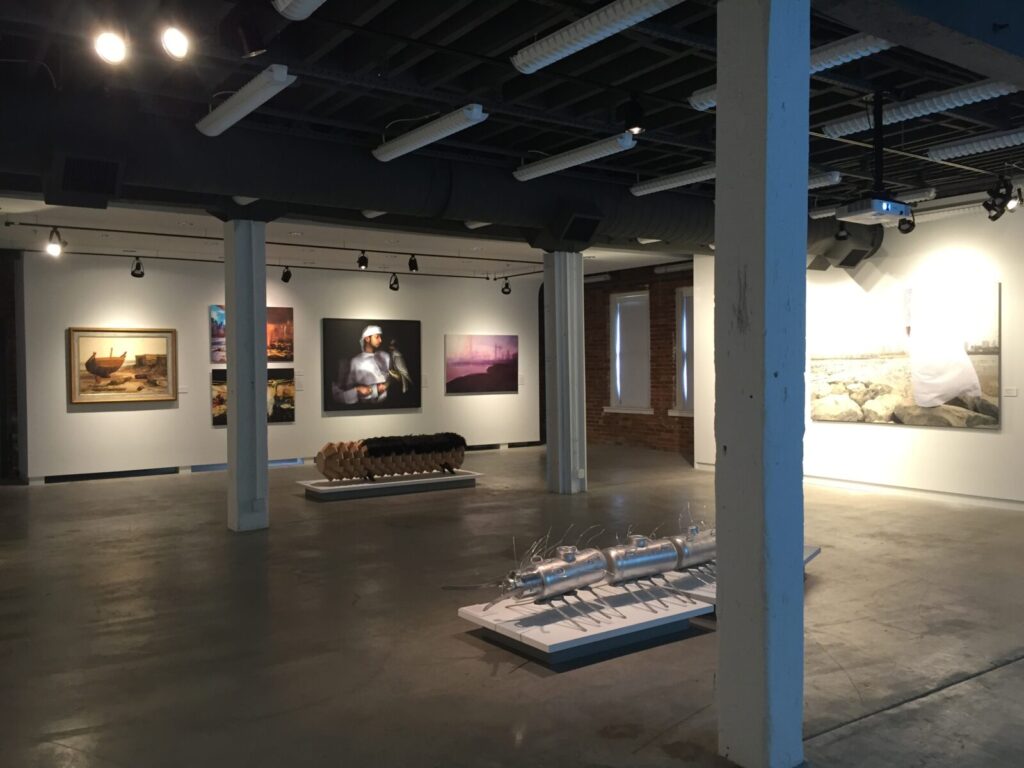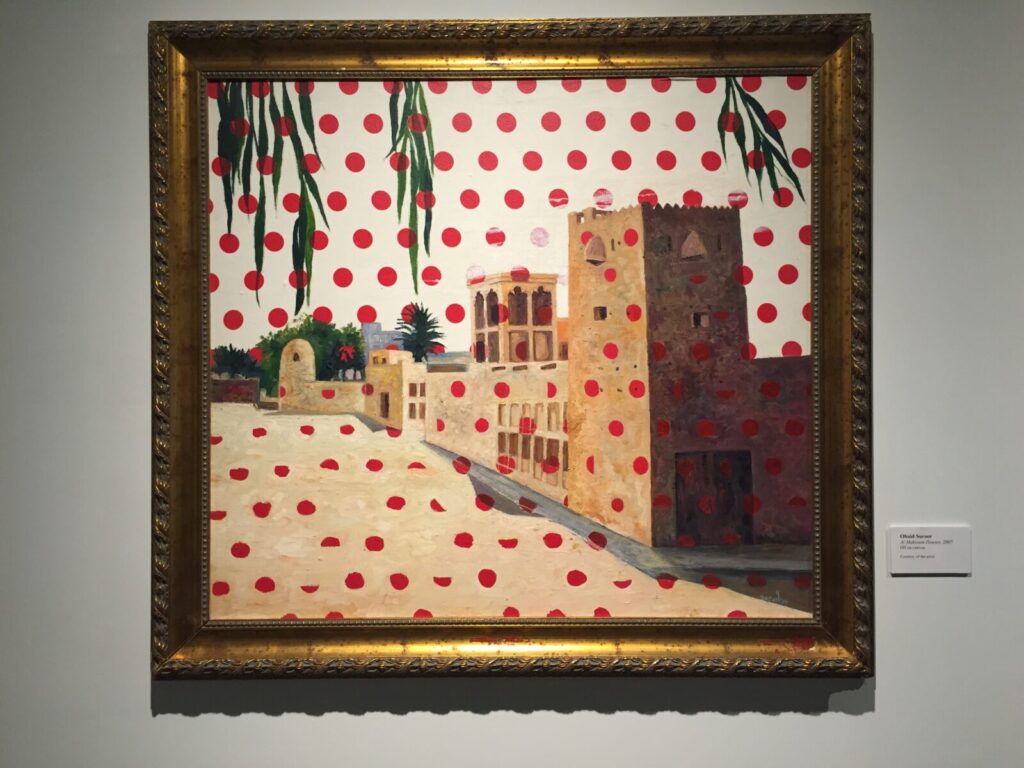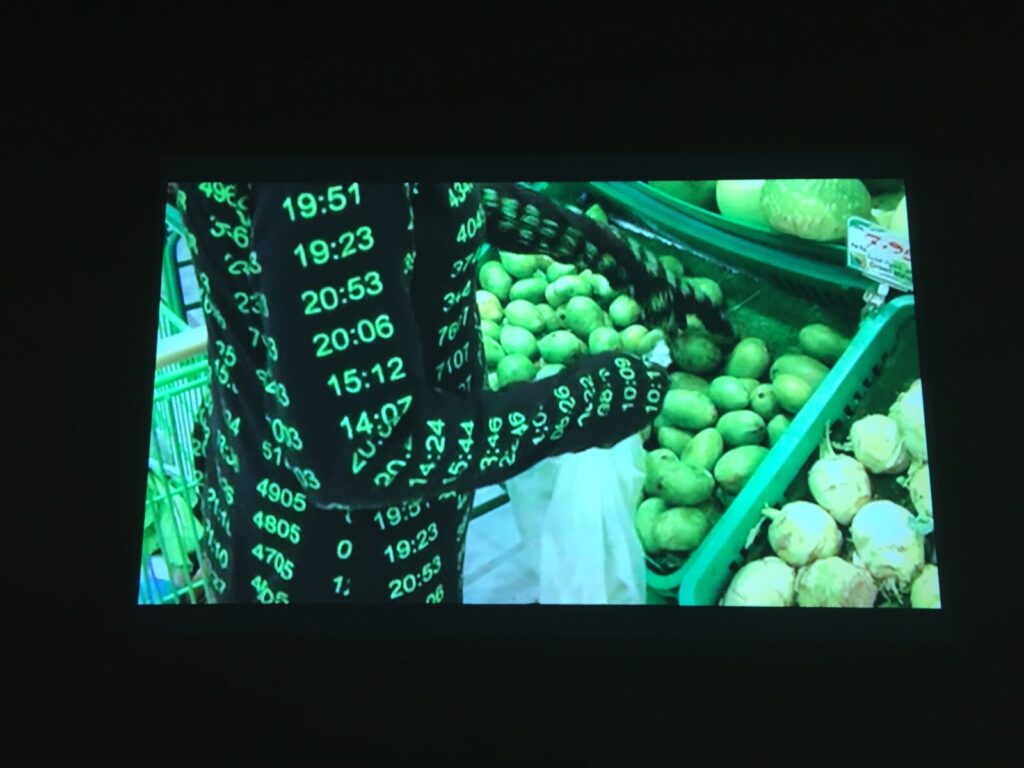Curatorial discourse has become increasingly self-reflexive, questioning the power structures that covertly or overtly influence museums, galleries, and cultural institutions. While curators are still tasked with caring for works of art, they also help us to navigate an artwork’s fluctuating cultural, historical, and political landscape, in addition to indicating the shifts that occur when a work is viewed on a local, national, or international platform. But what happens when platforms are fabricated by national embassies and curators become intertwined with diplomats?
Past Forward: Contemporary Art from the Emirates is co-curated by Noor Al Suwaidi and organized and circulated by the Meridian Center for Cultural Diplomacy (a nonprofit organization that aims to unite cultures) with support from the Embassy of the United Arab Emirates in Washington, D.C. According to Al Suwaidi, the twenty-five selected artists represent all seven emirates through emphasizing themes central to Emirati culture: home, family, nature, innovation, and technology.

Located in the University of Kentucky’s Bolivar Art Gallery, Past Forward is installed throughout three rooms, leaving adequate space between each video, sculpture, and two-dimensional work. The exhibition’s eighteen-month national tour concludes in Lexington, closing on May 13th, 2016. Past Forward is also accompanied by extensive programming that seeks to connect Emirati and North American culture—a sentiment echoed by both Al Suwaidi and the curatorial team from Meridian International through their catalogue essays.
This collaboration provides an opportunity for those in the United States to connect with artists living and working in the UAE through workshops, lectures, and panel discussions. Although the exhibition’s educational platform is a valuable resource, it silences any criticality layered within the selected artworks. Discussion revolves around the UAE’s industry and traditions, but only superficially.
While it remains impossible to separate the exhibition from its corporate and state sponsorships (a large sign bearing each institution’s insignia is strategically placed at the entrance), the works included in Past Forward tell a visual story of how art of the Emirates has changed since the country’s formation in 1971. An early painting by Abdul Qader Al Rais titled Obaid and Mouza (1968) is located toward the entrance, providing historical and aesthetic points of reference for the artists included in Past Forward. Al Rais’s paintings draw from figurative and abstract traditions, and have influenced and shaped contemporary art in the UAE. The artist pulls his inspiration from Emirati neighborhoods in addition to the local architecture.[1]

In an extension of Al Rais’s painting, Obaid Suroor layers themes of local architecture and culture but also highlights the importance of traditional Emirati fabric designs through dotted pop-art overlays. Old Houses (2007) and Al Maktoum Houses (2007) depict the mud brick houses and large forts of Ras Al Khaimah, an emirate often associated with its black rock mountains and ocean views.
Suroor has draped his architectural landscapes with dot patterns, but these additions are not merely placed on the painting’s surface; some dots respond to the buildings’ nooks and crannies and surrounding vegetation, as if being slowly absorbed by the canvas. Juxtaposing Suroor’s spotted landscapes with the square forms found in Al Rais’s figurative work documents a progression of abstraction in Emirati painting between the late 1960s and early 2000s.
Three large format photographs by Lateefa bint Maktoum are dispersed throughout gallery, providing reminders that while contemporary art in the UAE has become an important component of culture, Emirati traditions, landscapes, and natural environments are disappearing.
Two images capture figures looking outward to new industrial developments, like the Palm Jebel Ali—a large group of artificial islands located off the coast of Dubai, which are still under construction. In Observers of Change II (2009), bint Maktoum captures the effects of human intervention on the UAE’s ecology through a grove of mangled, leafless palm trees. The exhibition’s catalog and accompanying wall labels are uncomfortably optimistic—they treat bint Maktoum’s photographs as metaphors of perseverance in the face of change, yet evade lingering questions that surround the UAE’s industrial projects.
Hyperallergic, Art Forum, and the Chronicle of Higher Education are publications that continue to address the relationship between labor issues and art in the UAE; the Guggenheim Abu Dhabi, the Louvre Abu Dhabi, and New York University Abu Dhabi have been criticized for their exploitation of migrant labor. Last year, Ashok Sukumaran and Walid Raad were denied entry into the country due to their involvement with the Gulf Labour Coalition—an artist-initiated group that asks museums and institutions being built on Saadiyat Island to create better conditions for their workers.[2]

Only one of the works in Past Forward hints at the complexities associated with the UAE’s rapid growth. Projected in a small room at the gallery’s center is Ebtisam AbdulAziz’s filmed performance. Autobiography (2007) confronts issues of consumerism and personal wealth, probing the underlying structures that affect identity and culture.
For her performance, AbdulAziz wears a black, full-body suit covered in green numerals that are taken from her private bank statements. She wanders through public spaces, robotically performing parts of her daily routine. This narrative is interrupted by absurd interactions with consumer detritus—during one segment, the artist crawls into a large plastic bag and is dragged along a sidewalk. AbdulAziz’s work contributes to an international conversation on money and wealth, drawing similarities between the U.S. and UAE.
Maura Reilly’s essay “Toward a Curatorial Activism” questions the implications of institutional biases, asking what museum curators, directors, educators, artists, and gallerists can do to achieve fair and just representations of artistic production.[3] Past Forward fails to address the Embassy’s ideological subscriptions, offering its viewers a single—and problematic—perspective. It presents the UAE’s rapid globalization and industrial growth under a utopian blanket—one that acknowledges Emirati traditions are on a pathway to extinction, yet strategically covers the reasons its culture is changing so quickly. Critical discourse is subverted in favor of cultural diplomacy, prompting the questions: who is the curator—Al Suwaidi or the Embassy?
[1] Curtis Sandberg, “Telling the Emirati Story through Cultural Diplomacy” in Past Forward: Contemporary Art from the Emirates,” exh. cat. (Washington, D.C.: Meridian International, 2015), 5.
[2] “Letter from Sixty+ Curators, Critics and Museum Directors to UAE Art Institutions, and their Affiliates,” Gulf Labor Artist Coalition Website, June 1, 2015, http://gulflabor.org/2015/letter-from-sixty-curators-critics-and-museum-directors-to-uae-art-institutions-and-their-affiliates/.
[3] Maura Reilly, “Toward a Curatorial Activism,” MauraReilly.com, accessed April 27, 2016, http://www.maurareilly.com/pdf/essays/CIAFessay.pdf.




